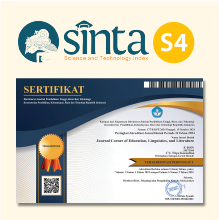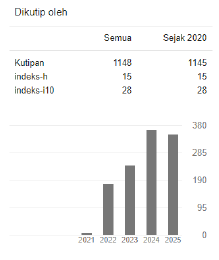The Realization of Genre Analysis on Students’ Essay: A Classroom Discourse Perspective
 https://doi.org/10.54012/jcell.v3i1.171
https://doi.org/10.54012/jcell.v3i1.171
 Abstract views: 1057
Abstract views: 1057
 PDF downloads: 738
PDF downloads: 738
Keywords:
genre analysis, students’ essay, classroom discourse analysisAbstract
Discourse analysis area becomes an essential issue in teaching and learning English in Indonesia. Through applying this approach, the lecturer as the researcher can analyze the students’ texts written during their writing course. This study was aimed at reporting the realization of genre analysis on students’ essay. Through employing discourse analysis approach, the writers selected 3 essays written by the freshmen from the Early Childhood Education Department, Islamic College of Putra Galuh Ciamis. In analyzing the texts, the writers employed context of culture or as the so-called ‘genre analysis’ to determine the social function, generic structure, and linguistics feature of the selected essays. In this study, the writer then addressed 3 research questions: (1) How is the social function of the texts realized? (2) How is the generic structure of the texts realized? (3) How is the linguistics feature of the texts realized? The findings of the study revealed that the realization of the social function of the essays is retelling past events for the purpose of informing or entertaining which was shown by the title of the text. The first essay entitled: “Student’s Skill Competition”, the second essay entitled: “Visiting My Grandmothers’ House”, and the third essay entitled: “Holiday in Pangandaran Beach”. Meanwhile, the realization of the generic structure covered: (a) introduction which tells orientation, (b) sequence of events which tells the events in the order they occurred, and (c) a conclusion which tells re-orientation. Moreover, the realization of the linguistics feature focused on (a) specific participants, (b) the use of past tense, (c) the use of material process and circumstances of time and place. In conclusion, dealing with the social function, generic structure, and the linguistics feature realized on the whole essays, the whole analyzed essays were categorized as recount texts.
Downloads
References
Anderson, M., and Anderson, K. (1998). Text Types in English. South Yarra, Australia: Macmillan Education Australia PTY LTD.
Bloor, T., and Bloor, M. (2004). The Functional Analysis of English: A Hallidayan Approach, 2nd Edition. London, UK: Arnold.
Butt, D, Fahey, R, Feez, S, Spinks, S, and Yollap, C. (2000). Using Functional Grammar, An Explorer’s Guide. Macquarie University-Sydney: National Centre for English Language Teaching and Research.
Christie, F. (2005). Language Education in the Primary Years. Australia: UNSW Press.
Creswell, J. W. (2012). Educational Research: Planning, Conducting, and Evaluating Quantitative and Qualitative Research, (4th Edition). Boston: Pearson Education, Inc.
Derewianka, B. (1990). Exploring How Texts Work. Sydney: Primary English teaching association.
Emilia, E. (2005). A Critical Genre-Based Approach to Teaching Academic Writing in a Tertiary EFL Context in Indonesia. Ph.D., Dissertation. Australia: University of Melbourne.
Eggins, S. (1994). An Introduction to Systemic Functional Linguistics. London: Pinter Publisher Ltd.
Eggins, S. (2004). An Introduction to Systemic Functional Linguistics, 2nd Edition. London: Continuum International Publishing Group.
Fraenkel, J. R., Wallen, N. E., and Hyun H., H. (2012). How to Design and Evaluate Research in Education, (8th edition). New York: The McGraw-Hill companies Inc.
Garot, L and Wignell, P. (1994). Making Sense of Functional Grammar. Sydney: Antipodean Educational Enterprises.
Halliday, M.A.K., and Webster, J.J. (Eds.). (2009). Continuum Companion to Systemic Functional Linguistics. London: Continuum International Publishing Group.
Harmer, J. (2007) The Practice of English Language Teaching, (4th edition). England: Pearson Education, Inc.
Hidayat, Y. (2014). The Ideational Meaning Realized in the Written Discourse in Online Newspaper on Abdul Qodir Jailani (AQJ). English Education Journal, 4(1), 24-30.
Hidayat, Y., Herniawati, A., & Ihsanda, N. (2022). The Use of Drilling Technique to Teach English Speaking to the Early Childhoods: A Descriptive Study. Journal Corner of Education, Linguistics, and Literature, 2(1), 73–80. https://doi.org/10.54012/jcell.v2i1.66.
Hyland, K. (2007). Genre and Second Language Writing. USA: University of Michigan Press.
Knapp, P., and Watkins, M. (2005). Genre, Text, Grammar, Technologies Teaching Assessing Writing. Sidney NSW: A UNSW Press Book.
Martin, J.R., and Rose, D. (2007). Working with Discourse, Meaning Beyond the Clause, 2nd Edition. London: Continuum International Publishing Group.
Mulatsih, S. (2007). The Realization of Ideational Meanings in Students’ Recounts. Celt Journal, 7(2), 143-157.
Nunan, D. (1999). Second Language Teaching & Learning. Boston: Heinle & Heinle Publishers.
Oshima, A., & Hogue, A. (2006). Writing Academic English, (4th Edition). USA: Pearson Education, Inc.
Rukimini, D. (2007). The Rhetorical Development Realizations of the Reading Texts of the Senior High School English Textbooks. Unpublished Dissertation. Semarang: Semarang State University (UNNES).
Wattless, I., & Radic-Bojanic, B. (2007). The Analysis of an Online Debate: The Systemic Functional Grammar Approach. Journal of Linguistics and Literature, 05(01), 47-58.
Downloads
Published
How to Cite
Issue
Section
License
Copyright (c) 2023 Yusuf Hidayat, Ani Herniawati

This work is licensed under a Creative Commons Attribution-ShareAlike 4.0 International License.
All articles published in the Journal Corner of Education, Linguistics, and Literature are licensed under the Creative Commons Attribution-ShareAlike License (CC BY-SA).

















